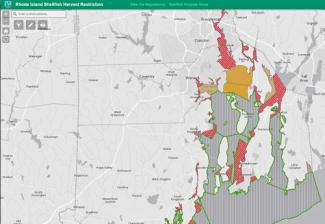Shellfishing
SHELLFISH HARVEST AREA CLOSURE ALERTS
Water quality-related shellfish harvest Conditional Area (rain) closures and emergency closures from harmful algal blooms, sewage releases, etc. are listed below.
Links to reference maps and written descriptions of RI shellfish waters with seasonal and year-round water quality related shellfish harvest closures are provided below.
As required by RI General Law § 20-8.1-3 DEM continues to use the 24-hour shellfish hotline (401-222-2900) as the primary tool for providing notice of harvesting restrictions.
Information regarding shellfish management restrictions, minimum sizes, and possession limits: Shellfish & Regulations.
Pollution-Related Conditional Area and Emergency Shellfish Closure
Updated 12/10/2025
Location |
Status |
Scheduled to Reopen |
|---|---|---|
Upper Bay Conditional Area 1A |
OPEN |
|
Lower Providence River Conditional Area 16E* |
OPEN |
|
Greenwich Bay* |
OPEN |
|
Mount Hope Bay |
OPEN |
|
Kickemuit River |
OPEN |
|
Pt Judith Pond Conditional Areas |
OPEN |
|
*Please be reminded that Greenwich Bay and Providence River are designated Shellfish Management Areas with defined harvest seasons. Please see the DEM regulation Part 4 - Shellfish for description of harvest seasons in Shellfish Management Areas or contact the DEM Division of Marine Fisheries at 401-423-1920.
Current Status of CONDITIONALLY APPROVED shellfish areas or emergency shellfish closures may be obtained by calling the Shellfish Closure Hotline 401-222-2900, 24-hours a day.

If you have questions or concerns about shellfish closures, you may call 401-222-4700 or email them to dem.shellfish@dem.ri.gov. You may also sign up to receive email notifications of conditional area and emergency shellfish closures through our new email alert system Constant Contact by clicking here.
Where Can I Shellfish?
The DEM Shellfish Program classifies all shellfish harvest waters within the limits of Rhode Island state waters for the enjoyment of recreational shellfish harvesters and for the commercial shellfish industry. Click the map image below to view the approximate boundaries and the current classification of these areas.
The boundaries shown on these maps are a general reference only. The written description of each classified area supersedes these map depictions and can be found by following the identified links within the map or in the document below

Click the map to go to the interactive map feature
All waters of the state that are designated for shellfish harvesting have been identified and named as individual Growing Areas (GA1 – GA 17) with area specific classifications and boundaries.
Maps and descriptions of the individual shellfish growing areas and their current classifications can also be found here:
The State of Rhode Island is a member of the Interstate Shellfish Sanitation Conference. The Interstate Shellfish Sanitation Conference (ISSC) was formed in 1982 to foster and promote shellfish sanitation through the cooperation of state and federal control agencies, the shellfish industry, and the academic community. Rhode Island must abide by rules and guidance set forth in the National Shellfish Sanitation Program's (NSSP) Model Ordinance in order to operate as an interstate shellfish state.
Other Important Information
- In addition to pollution closures both recreational and commercial shellfish harvesters need to be aware of DEM Division of Marine Fisheries management and catch regulations. DEM Division of Marine Fisheries sets size, quantity, and seasonal harvesting limits and has designated areas in approved shellfish harvesting waters that have additional management limitations. Refer to their recreational and commercial fishing laws for the complete text of these regulations.
- Always remember shellfish harvesting will be allowed only when declared OPEN by the DEM Office of Water Resources based upon water quality considerations.
- Regulations and notices of Polluted Shellfish Grounds by the Office of Water Resources shall supersede the regulations cited above.
- DEM's Division of Law Enforcement Marine Unit provides patrol and enforcement of the shellfish growing area classifications and boundaries and information on this element of the sanitary control of the shellfish industry along with other marine enforcement duties.
Shellfish Classifications
There are three classifications of shellfish harvest waters in the State of Rhode Island.
Call 401-222-2900 (24/7) for information on CONDITIONALLY APPROVED areas of Upper Narragansett Bay, Greenwich Bay, Mount Hope Bay, or the Kickemuit River or Point Judith Pond and emergency closures.
Shellfish Wholesalers and Dealers
The state annually issues numbered certificates to shellfish dealers who comply with the agreed-upon sanitary standards & forwards copies of the interstate certificates to the U.S. Food and Drug Administration. The FDA makes an annual review of each state shellfish control program, including the inspection of a representative number of shellfish processing plants & publishes a list of valid interstate shellfish shipper certificates. View Rhode Island Department of Health's shellfish inspection program information.
Additional Resources
- RIDOH Shellfish Inspection Program
- RIDEM Division of Law Enforcement
- RIDEM Division of Marine Fisheries
- RIDEM Licensing and Boater Registration
- US Food and Drug Association
- Interstate Shellfish Sanitation Conference
- National Shellfish Sanitation Program
- RI Shellfish Management Plan
- East Coast Shellfish Growers Association
- National Shellfisheries Association
